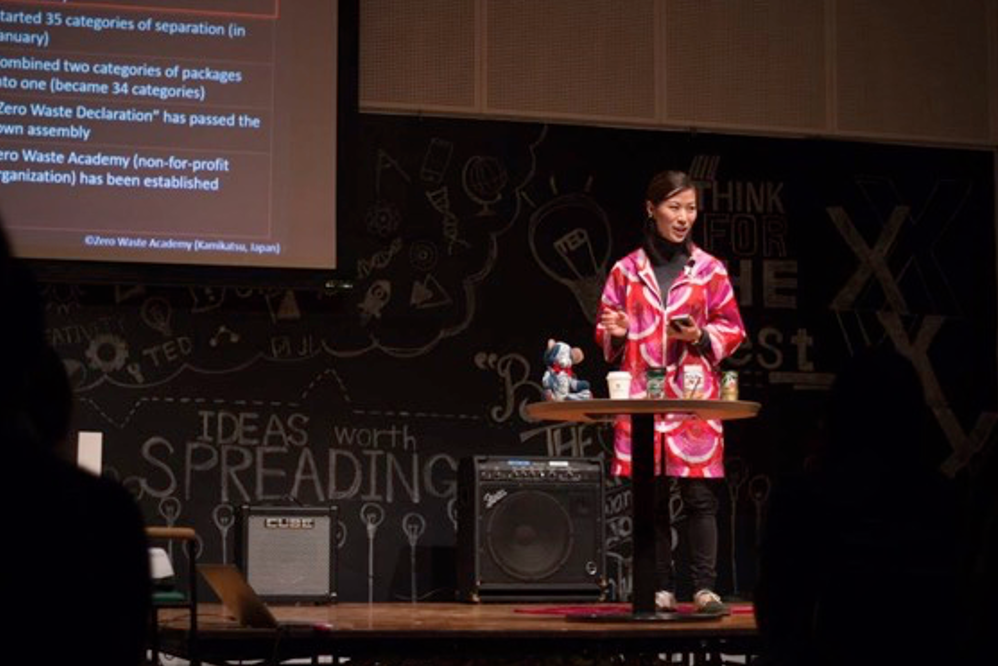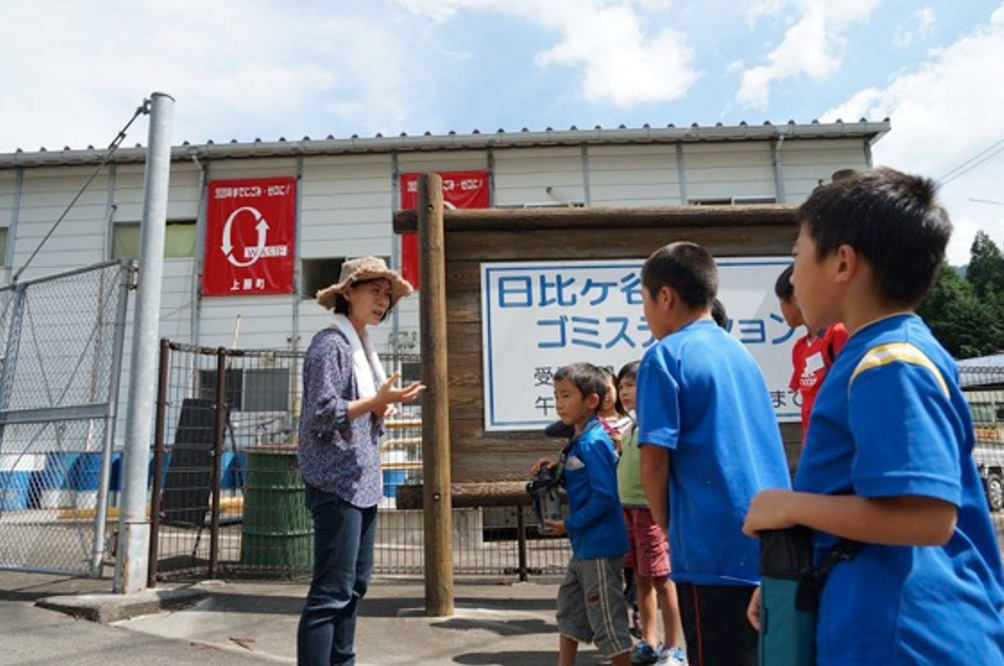

ー
How do you now see the potential of biotechnology and enzymes?
Ms. Sakano
I have always loved wildlife, so I enjoy keeping up with the latest in biomimicry technology. I see a lot of potential for bio-based materials. I think we can expect to see more and more of them in the textile industry and various other fields.
I think that creating new materials is, by its very nature, innovative and full of possibility. In the field of waste, although there has recently been some controversy surrounding “bioplastics,” I want to learn more about how we can capture the potential of bio-based materials.
ー
The word “bioplastics” has a positive ring, so people might assume that they are all biodegradable. Are there any problems associated with them?
Ms. Sakano
What’s confusing is that there are two types of bioplastics under Japan’s classification scheme. Basically, one type are materials that are meant to be biodegradable; the other type are plastic-like materials derived from plants.
Another complication is that “derived from plants” does not necessarily mean “biodegradable.” On the other hand, some petroleum-based materials are biodegradable. There is a lot of confusion about these categories. Just because something is labeled “bio,” you can’t assume that it’s OK to bury it in landfill or flush it into the river. Far from it!


Sakano speaking at TED×APU 2016
Photo by Cao Mieu
ー
You mean that such materials will persist in the natural world?
Ms. Sakano
That’s right! Even the word “biodegradable” has various levels of meaning, depending on how difficult it is for the material to biodegrade in a particular medium, such as seawater or fresh water, when buried in soil, or when composted.
Take paper for example. It is made of cellulose, a plant fiber, so you would think it is biodegradable. But it can take a long time for the paper to break down. If you just leave it, it could take hundreds or thousands of years. If paper is buried in soil or compost, however, hard-working enzymes can shorten the decomposition time to a few years or months.



ー
Definitely! The fibers of books or clothing excavated from ancient archaeological sites are sometimes well preserved.
Ms. Sakano
In Japan, some composite materials are produced by mixing a conventional plastic with a certain percentage of bioplastic. These are labeled as “X% bio materials.” But from a recycling point of view, this is like a material that contains a foreign substance or contaminant. For plastic recyclers this has become a tough problem.


ー
If a material is not biodegradable and also difficult to recycle, that is clearly a problem.
The main focus of textile products around the world these days is durability. In the future, though, manufacturing will probably need to focus more on degradability. So, how can we utilize materials that will definitely decompose after a few years? If we take advantage of the power of certain microorganisms or enzymes, we can make it easier for materials to decompose. It would be good if we could shift people’s thinking in this direction!



Ms. Sakano
If we want to get serious about bioplastics, what do we have to do? If want them to be biodegradable, we have to develop ways to make them biodegradable, and if we want to recycle them properly, we need systems to separate and collect them. If bioplastics are introduced without a clear idea of what to do with them at the end of their useful life, it’s hard to see how they can achieve widespread adoption.
Another essential requirement for new materials is that they have to be economical; otherwise, they can’t be successful. Hmm! How can we change people’s attitudes?



ー
Speaking of biodegradability, just 20 years ago very few people knew or cared about ocean plastic, but in recent years it has become a serious and widely known global issue. The apparel industry, for example, has become very conscious about its corporate activities and this attitude is spreading to other industries.
Ms. Sakano
Yes, in recent years it’s become a high-profile issue that more and more people are concerned about. This is a good example of how something that was off the radar years ago is now known widely by nearly everyone.
ー
Earlier we touched on the different levels of degradability. The ocean was the most difficult medium in terms of degradability.
Ms. Sakano
Apparently, plastic manufacturers are trying to develop products that decompose easily in the ocean, and there is ongoing research aimed at developing enzymes that can break down plastics. Even if large pieces of plastic cannot be decomposed completely, we can try to develop enzyme processes capable of breaking down microplastics. I hope that we will see new enzymes like this emerge and become used worldwide.
ー
Several of the previous interviews in this series have focused on fermentation. When we posed the question, “What is the difference between fermentation and rotting?” we learned that the two phenomena are the same. The difference depends solely on whether the process is considered good or bad for humans. A similar logic applies to waste. What is waste for humans? What is waste from the perspective of the planet? And if we take a cosmic perspective, is there anything at all that we could regard as waste?
Ms. Sakano
This point about the difference between fermentation and rotting is interesting. First of all, there is no such thing as waste or garbage in the natural world; waste is generated only when there are humans. The practice of making things that eventually become unusable and that cannot be disposed of is a feature of human society. As Enzo said earlier, if we set out from the beginning to make things that can be decomposed, we can perhaps come closer to the system of the natural world.


Ms. Sakano
Judging whether or not something is, in essence, waste is a very subjective and artificial matter. That is why there is actually no clear definition of waste. The basic point is that everyone draws their own line between what is necessary and what is waste.
ー
I was struck by this notion that waste is man-made. In a recent paper published in the British scientific journal Nature (doi: 10.1038/s41586-020-3010-5), I read that for the first time in human history, the quantity of man-made objects has exceeded the quantity of natural objects.
I understand that the report claims that the total weight of everything created by humans, including buildings and structures, is now greater than the total weight of all the living things in the natural world (1.1 trillion tons).



Ms. Sakano
I believe that the population of the earth has grown too much, which means that human activities have already surpassed the capacity of nature. Consider food or clothing. We have to produce a certain amount, consume it all, and then produce it again. This cycle takes a long time, so natural systems are never able to keep up.
What I would like to see is a shift to the concept of “regenerative” systems, as they are sometimes known these days. In such systems, material is used continuously, even as it is generated and regenerated. It could even work for materials like bioplastics. Rather than simply repeating the cycle of replanting and harvesting endlessly, what if we use plants that regenerate quickly as raw materials? Or what if we could make skillful use of plants that are otherwise regarded as a nuisance.


© World Economic Forum / Sikarin Fon Thanachaiary
Ms. Sakano said that only humans produce waste, but of course humans generate waste in order to live and survive. So, how can we coexist with waste, I wonder?



ー
Waste equals stuff made by humans when they engage in productive activities. So, if we can increase the reuse rate to a very high level, through skillful recycling and other means, we could get closer and closer to a zero waste society. But is such a zero waste society really possible?
Ms. Sakano
When I am asked this question by an elementary school student, I say, “Yes, we can.” In a corporate setting, on the other hand, I tend to respond by questioning the questioner (laughs). My simple answer is that it is possible to create a future society in which we no longer generate any waste and recycle everything we produce.
To make zero waste a reality, we have to look at waste as a resource, right? Once that starts to happen, we can move toward a world without waste. Ideally, enzymes will play a valuable role in that cycle.



Ms. Sakano
If you look around the planet, though, you see that there is a huge amount of waste that has already been created. We can’t expect that to disappear immediately. It will take quite a long time before there is no waste at all, and ultimately it may not all disappear.
ー
Is there anything that you would like to ask Enzo?
Ms. Sakano
I still have so much to learn, but as Enzo said earlier, enzymes capable of breaking down plastic are starting to be created. I’ve also heard that microorganisms containing such enzymes arise spontaneously in the vicinity of factories where plastics are produced or recycled. Wouldn’t it be great if we could take advantage of these naturally occurring microorganisms? What do you think about that, Professor?


Well, obviously, enzymes don’t care about breaking down stuff for humans. As we mentioned earlier, fermentation and rotting are basically the same thing. Microorganisms just make use of what is there. Such biological phenomena result from a very complex interplay of chemical reactions. Yes, enzymes are involved in many biological processes. You could say that enzymes are an essential ingredient of life, or of the natural environment. I believe that there is a way for humans to make the best use of enzymes, to coexist with the earth, and to live in harmony with all life.



ー
Enzo seemed a little annoyed about the arrogance of human beings (laughs). Humans are somewhat selfish, after all. They try to manipulate time, totally ignoring the speed of nature, or else they exploit nature for their own convenience. In the coming years, R&D on enzymes and biotechnology will probably produce all sorts of technologies. But there is a lot of room for humans to improve their attitude to the environment and work harder to improve it.
I'm glad that people have high expectations for enzymes, but I also hope that humans can do their best to change their behavior. Instead of trying to solve problems through the power of science, I think that a greater impact can be achieved by making sure that individuals do not generate waste. The fact that enzymes show up in all kinds of chemical reactions around the planet and in such a wide variety of natural phenomena is quite a mystery to people. Enzymes seem to promise almost unlimited potential. Hopefully people will respect all living things and continue reflecting on how to help achieve a zero waste world.



ー
I feel that it is very important to feel a sense of respect for invisible forms of life, as expressed by the “tombstone” for fungi at Amano Enzyme. Lastly, Ms. Sakano, could you tell us something about your future goals and dreams?
Ms. Sakano
I see a lot of real diversity. Different regions and localities will have different initiatives, with different people approaching things in different ways. In some cases, legislation may bring about positive and dramatic changes, but ultimately, I think it is important for a wide variety of people to tackle the problem of waste through localization and customization. Wouldn’t it be nice if we could create opportunities in many different places to think together deeply about these issues in the coming years.


ー
In previous interviews, there was a part of me that felt that enzymes could solve almost any problem. But I have realized that we also need to be humble and work to reduce waste in other ways. I really learned a lot today!
Listening to Ms. Sakano’s words, we felt strongly that society is not something that is given to us, but rather something that we create as human beings. In tackling the problem of waste, we will probably need to rebuild industries using low technology as well as high technology, in accordance with the approach of the “4Ls.”
Initiatives to revitalize local communities will also become increasingly important in the future. This may well lead us to solving other issues, like that of Japan’s aging population. We have great expectations for Ms. Sakano’s activities, which in a sense seem to go against the grain of globalization, despite the fact that she shares her work and spreads her message throughout the world. We wish her all the best with her future activities.
Enzymes are active in every aspect of our world, and we are seeking new possibilities for them.
In this corner, we visit people who are currently active in various fields with "Enzo" and ask them about their stories.

